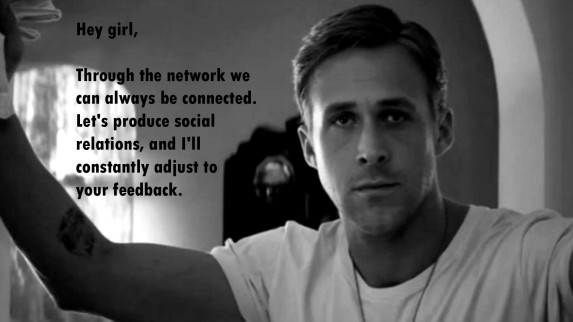What is the theoretical value of a short clip of Tina Fey “high-fiving a million angels”? What does a GIF say about new media aesthetics and how we conceive of authorship/ownership? The now ubiquitous GIFs and memes are what Henry Jenkins defines as spreadable media. The prototypical word used for media that moves virally through an online network is meme, a term that was coined by Richard Dawkins to explain how cultural ideas, practices, and symbols are transmitted “by leaping brain to brain via a process which, in the broad sense, can be called imitation” (Dawkins 189). Unlike the cultural memes Dawkins theorized, Internet memes do not maintain fidelity or an unaltered state as they pass from “brain to brain.” In their study of online memes, Michael Knobel and Colin Lankshear discovered that many were altered, “the meme ‘vehicle’ was changed, modified, mixed with other referential and expressive resources, and regularly given idiosyncratic spins by participants” (208).
A recent example of an online meme that has propagated due to modifications is the “Ryan Gosling says Hey Girl” meme. The meme began on a Tumblr feed entitled Fuck Yeah! Ryan Gosling when a captioned picture was posted that stated, “Hey girl, No Shoes, Clear Eyes, Full Heart, Can’t Wait to Kiss You” (Jezebel). This led to a circulation of a whole series of captioned Ryan Gosling photos that began with the words “Hey girl.” It spawned a derivative blog entitled, Feminist Ryan Gosling, where after the opening of “Hey girl,” the captioned Ryan Gosling delivers musings/statements related to feminist theory and literature, such as “Derrida thinks language is fluid enough to break the gender divide, but nothing will split us apart” (Henderson). At the point of this most recent iteration, who is the creator of this text? Tumblr user Jezebel wrote a caption on a photo she did not take and uploaded it to a site that she did not create. Danielle Henderson parodied the original meme to promote a feminist agenda and perhaps promote herself as an academic and writer, as her feminist Ryan Gosling Tumblr led to a book contract. Analysis of her usage led me to create my own Ryan Gosling meme, which I used in my dissertation defense, which was the final step to earning my doctorate.

If we consider aesthetics as a way of judging the value of art, then the aesthetics of online media/art involves how easily and likely a text is to be “appropriated and reworked by a range of different communities” (Jenkins et al 2). Because viral media and memes rely on the audience to transform and repurpose the original text, the value of a piece is co-determined by the audience. To reach an audience and elicit their participation, pathos is needed. According to Jenkins, Ford, and Green, spreadable media most commonly contain: “absurd humor or parody,” “puzzles or enigmas which encourage us to seek out other information,” a need for audience participation to be complete, and “themes of community and nostalgia” (6). As Micciche argued, emotions bind a social body together. Online, emotions are the catalyst behind likes, shares, and posts. We are not only circulating images and information, but emotions.
Understanding the aesthetics of new media texts should be recognized as a form of literacy. “Literacies call us to generate and communicate meanings and to invite others to make meaning from our texts in turn,” explain Lankshear and Knobel, “This, however, can only be done by having something to make meaning from—namely, a kind of content that is carried as ‘potential’ by the text and that is actualized through interaction with the text by its recipients” (4). Whether this type of literacy should be referred to as digital literacy, electracy, aesthetic literacy, or critical literacy is up for grabs. What is clear is that we must reconceptualize literacy, authorship/ownership, and aesthetics to glean the most from the affordances of new media.
Works Cited:
Dawkins, Richard. The Selfish Gene. Oxford University Press, 1990.
Henderson, Danielle. Feminist Ryan Gosling. Tumblr, 2013.
Jenkins, Henry, Sam Ford, and Joshua Green. Spreadable Media: Creating Value and Meaning in a Networked Culture. NYU Press, 2013.
Jezebel. “Hey girl, No Shoes, Clear Eyes, Full Heart, Can’t Wait to Kiss You.” Fuck Yeah! Ryan Gosling. Tumblr, 2012.
Knobel, Michael and Colin Lankshear. A New Literacies Sampler. Peter Lang, 2007.
Micciche, Laura. Doing Emotion: Rhetoric, Writing, Teaching. Heinemann, 2007.
